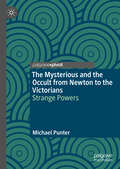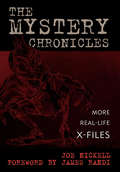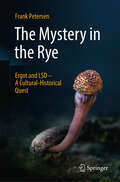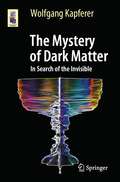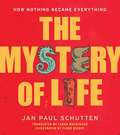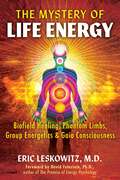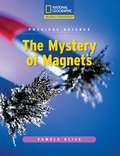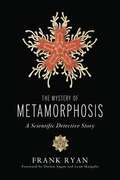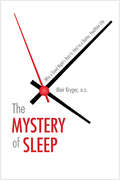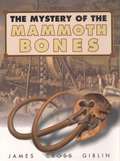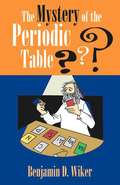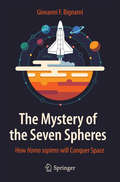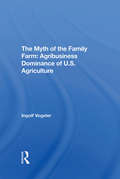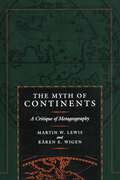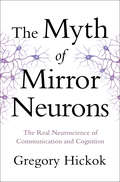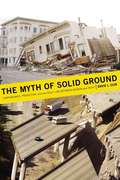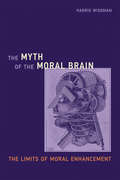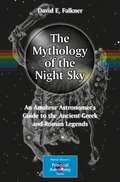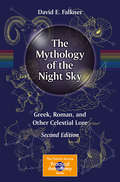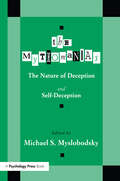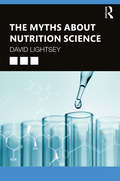- Table View
- List View
The Mysterious and the Occult from Newton to the Victorians: Strange Powers
by Michael PunterThis book examines the search for ‘occult’ or hidden forces in the two centuries after Newton’s theory of gravity. It investigates how history has simplified the work of some of the key figures of the age, presenting them as ‘legitimate’ and removing their more complex motivations. This book is a scholarly but readable exploration of forces we rely upon (electricity) and ones we have abandoned (vital fluid, animal magnetism). Ranging across literature, drama, philosophy and science, it demonstrates how hopes, fears and anxieties around occult phenomena have been expressed over time.
The Mystery Chronicles: More Real-Life X-Files
by Joe Nickell&“Science-based explanations for unusual happenings [and] documented solutions for more than three dozen mysteries.&” ―Dallas Morning News Investigator Joe Nickell has spent over thirty years solving the world&’s most perplexing mysteries. This new casebook reveals the secrets of the Winchester Mystery House, the giant Nazca drawings of Peru, the Shroud of Turin, the &“Mothman&” enigma, the Amityville Horror house, the vicious goat-sucking El Chupacabra, and many other &“unexplainable&” phenomena. Nickell has traveled far and wide to solve cases, which include a weeping icon in Russia, the elusive Bigfoot-like &“yowie&” in Australia, the reputed power of a headless saint in Spain, and an &“alien hybrid&” in Germany. He has gone undercover—often in disguise—to reveal the tricks of those who pretend to talk to the dead; accompanied a Cajun guide into a Louisiana swamp in search of a fabled monster; and gained an audience with a voodoo queen. Superstar psychic medium John Edward, pet psychic Sonya Fitzpatrick, evangelist and healer Benny Hinn, and many other well-known figures have found themselves under Nickell&’s careful scrutiny. The Mystery Chronicles examines more than three dozen intriguing mysteries, as Nickell uses a hands-on approach and the scientific method to steer between the extremes of mystery mongering and debunking. With a foreword by James Randi &“His varied work experience as a private investigator, forensic document analyst, stage magician, carnival pitchman, and English professor gives him credibility as a hard-nosed researcher and writer.&” —Booklist &“In straightforward, understated prose, Nickell describes frauds, deceptions and instances of superstition among vulnerable and gullible victims, some of which he exposed by covert investigations.&” —Publishers Weekly
The Mystery in the Rye: Ergot and LSD – A Cultural-Historical Quest
by Frank PetersenThere are countless reports on microorganisms and their special abilities. The saga of the ergot fungus is perhaps the most unusual of them all. The unique history of this plant pathogenic microbe, which began with its infection of grasses, is told through a broad storyline that stretches from the early medical writings of Mesopotamia, Greece, and China, to the industrial and academic laboratories of pharmaceutical research in the 21st century.... Among cultivated grasses, the ergot fungus mainly infests rye. Its overwintering structure, the black-purple ergot kernel, grows out of the ears of the grain. The highly active substances it contains caused mass poisonings in Europe over a period of 1,000 years, in the course of which the victims suffered from terrible symptoms of illness. Only in the 17th century, doctors recognized ergot as the corpus delicti for the regularly recurring waves of mass poisoning. The development of drugs from pure ergot compounds is one of the fascinating contributions of pharmaceutical natural product and medicinal chemistry and was of great importance for the modernization of medicine. A straight line can be drawn from this research to the synthesis of LSD, whose accidentally observed psychotropic effect revealed the chemical basis of the psyche. In combination with other centrally active substances, the LSD studies opened the therapeutic research field of psychopharmacology. The ergot fungus stands for legendary advances in pharmaceutical science and human therapy. At the same time, the people who investigated this unique microorganism scientifically, for a wide variety of reasons, became part of its cultural history. Throughout the centuries, they have kept the wheels turning - an innovative power which is still effective today.
The Mystery of Dark Matter: In Search of the Invisible (Astronomers' Universe)
by Wolfgang KapfererGet ready to embark on the exciting search for dark matter—the invisible mass that dominates our universe. This popular science book explains why this mysterious dark matter has been incorporated into the standard model of the universe and how scientists are able to “observe” the invisible. The book starts with the early indications of the existence of dark matter, including the strange cohesion of galaxy clusters, before moving on to modern observations like cosmic background radiation. Along the way, you will learn about the direct and indirect methods being used by researchers to track down dark matter and whatever is behind this strange phenomenon.The Mystery of Dark Matter will appeal to general readers who wish to understand what scientists actually know about dark matter, along with the methods they use to help crack the mystery. This book is a translation of the original German 1st edition Das Rätsel Dunkle Materie by Wolfgang Kapferer, published by Springer-Verlag GmbH Deutschland in 2018.The translation was done with the help of artificial intelligence (machine translation by the service DeepL.com). A subsequent human revision was done primarily in terms of content, so that the book will read stylistically differently from a conventional translation. Springer Nature works continuously to further the development of tools for the production of books and on the related technologies to support the authors.
The Mystery of Life
by Jan Paul Schutten Floor RiederHow did nonliving atoms evolve into modern people? Find out in this engaging illustrated exploration of how nothing became everything.The science of evolution is a topic of utmost importance, especially as the focus on STEM (Science, Technology, Engineering, Math) education continues to increase. Fortunately, important doesn't have to mean boring. From explaining how scientists discovered how life began on earth to speculating about whether space aliens are carnivores, this engaging investigation of all things evolution is infused with fun as well as facts. Coupled with gorgeous illustrations, curious minds yound and old will discover how to build a planet, the truth about DNA, whether trees really want to be tall, how to survive without a butt, and much, much more!
The Mystery of Life Energy: Biofield Healing, Phantom Limbs, Group Energetics, and Gaia Consciousness
by Eric Leskowitz• Describes how energy therapies are now gaining acceptance due to irrefutable proof of their effectiveness for clinical conditions from PTSD to phantom limb pain • Examines the power of group energetics and team chemistry in sports and in society • Explains how megalithic sacred sites are aligned with Earth&’s subtle energies and explores the energetics of crop circles and global consciousness Examining the wealth of evidence supporting the reality of the human biofield, Eric Leskowitz, M.D., explores the role of life energy in healing therapies and outlines its many manifestations at the individual, group, and global levels. He shows how energy therapies have been taboo in the West, from the French Royal Academy&’s suppression of Franz Mesmer&’s animal magnetism, to the FDA&’s persecution of Wilhelm Reich and his orgone box therapy, to Wikipedia&’s biased coverage of energy psychology. He then reveals irrefutable evidence for the clinical benefits of energy-based therapies and describes the obstacles he faced in his own attempts to bring these holistic approaches into the world of academic medicine. The author&’s detailed exploration of phantom limb pain shows that this phenomenon is not a psychosomatic creation of the brain but is a tangible energetic structure: the human biofield in action. Exploring group energetics and team chemistry, he looks at how group situations— a concert, a meditation retreat, a sporting event—create their own energetic power. He shares the results of his innovative computer measurements during Red Sox baseball games, proving that group energies can be detected when fans become entrained in resonance to the larger field. He explores how Stonehenge and other megaliths were built in alignment with Earth&’s own energy meridians, and he proposes that the mysterious phenomenon of crop circles may be emerging in harmony with Earth&’s subtle energies. Blending hard science with ancient healing wisdom, the author reveals how we can all thrive together by remembering our shared energetic roots and our undeniable interconnectedness through the global web of life energy and consciousness itself.
The Mystery of Magnets
by Pamela BlissDescribes how magnets act on objects and other magnets. Explains how Earth is a magnet. Identifies historical discoveries about magnetism. Explores the relationship between electricity and magnetism.
The Mystery of Metamorphosis
by Frank RyanMetamorphosis has intrigued human observers for thousands of years. While everyone knows this trick of nature transforms caterpillars into butterflies, fewer are aware that this process of transformation also occurs in many other insect species, as well as in amphibians and-in its greatest diversity-in marine creatures. Still, despite its widespread occurrence, metamorphosis has largely remained a mystery-not just to the people who watch gorgeous orange Monarchs emerge from green caterpillars once ensconced in cocoons, but also to the scientists who have tried to unravel just how the transformation works. InMetamorphosis, Frank Ryan delves into the mystery headfirst, showcasing surprising new ideas that are shaking established science. Ryan recounts how the intricate physiology of metamorphosis has slowly revealed its secrets. He brings the work of pioneering scientists-such as Jean-Henri Fabre, Vincent Wigglesworth, and Carroll Williams-to life as they explore the inner workings of the insect world. We also meet contemporary scientist Don Williamson, whose work on sea urchins and other ocean-going animals led him to a theory of larval development that challenge some of the longest-held beliefs in evolution-including those that date back to Darwin's time. Williamson, whose revelations have launched huge debates in science, has risked being labeled an iconoclast for encouraging people to think differently about how species evolve-a process, he says, that is not as linear as we've believed, and that involves not just mutation but also hybridizaton. A character as enchanting as metamorphosis itself, Williams exemplifies the importance of questioning time-honored beliefs. Through his work and those of the other monumental scientists in this book, we come closer to understanding the ancient and miraculous transformation of juvenile life forms into beautiful and complex adult insects and animals.
The Mystery of Sleep: Why a Good Night's Rest Is Vital to a Better, Healthier Life
by Meir KrygerAn authoritative and accessible guide to what happens when we shut our eyes at night We spend a third of our lives in bed, but how much do we really understand about how sleep affects us? In the past forty years, scientists have discovered that our sleep (or lack of it) can affect nearly every aspect of our waking lives. Poor sleep could be a sign of a disease, the result of a vitamin or iron deficiency, or the cause of numerous other problems, both sleeping and waking. Yet many people, even medical personnel, are unaware of the dangers of poor sleep. Enter Dr. Meir Kryger, a world authority on the science of sleep, with a comprehensive guide to the mysteries of slumber that combines detailed case studies, helpful tables, illustrations, and pragmatic advice. Everyone needs a good night's sleep, and many of us will experience some difficulty sleeping or staying awake over the course of our lifetimes (or know someone who does). Kryger's comprehensive text is a much-needed resource for insomniacs; for those who snore, can't stay awake, or experience disturbing dreams; and for the simply curious. Uniquely wide ranging, The Mystery of Sleep is more than a handbook; it is a guide to the world of sleep and the mysterious disorders that affect it.
The Mystery of the Aleph
by Amir D. AczelThe history of infinity emphasizing the people who were interested in the concept. Stresses philosophical and religious importance of mathematical ideas throughout history. Fascinating even if math is not your strong suit.
The Mystery of the Black Hole Mine (D. J. Dillon Adventure #7)
by Lee RoddyD.J. gets a bad case of "gold fever" when he and Alfred accidentally discover an abandoned-- and mysteriously dangerous-- gold mine.
The Mystery of the Mammoth Bones, And How It Was Solved
by James Cross GiblinDescribes the efforts of the artist, museum curator, and self-taught paleontologist, Charles Willson Peale, to excavate, study, and display the bones of a prehistoric creature that is later named "mastodon."
The Mystery of the Monarchs: How Kids, Teachers, and Butterfly Fans Helped Fred and Norah Urquhart Track the Great Monarch Migration
by Barb RosenstockA gorgeous picture book based on the true story of a scientist who solves the mysteries of monarch butterfly migration—with the help of schoolchildren! A perfect story for nature lovers of all ages from the Caldecott Honor winning author of The Noisy Paint BoxYoung Fred Urquhart was fascinated by insects, especially his favorite, the monarchbutterfly. He wondered where monarchs spent the winter. No one knew. After he became an entomologist (bug scientist),Fred and his wife, Norah,tagged hundreds of butterflies,hoping to solve the mysteryof the monarchs. But they soon discovered that they needed help. They started a &“butterfly family,&” a community of children, teachers, and nature enthusiasts fromthree countries––Canada, the United States,and Mexico––to answer the question: Where do the monarchs go? Detailed materials in the back of the book include maps of monarch migration, the life cycle of the butterfly, and the cultural relevance of monarch butterflies in Mexico, as well as information on environmental efforts towards monarch conservation.
The Mystery of the Periodic Table (Living History Library)
by Benjamin WikerThe author leads the reader on a delightful and absorbing journey through the ages, on the trail of the elements of the Periodic Table as we know them today. He introduces the young reader to people like Von Helmont, Boyle, Stahl, Priestly, Cavendish, Lavoisier, and many others, all incredibly diverse in personality and approach, who have laid the groundwork for a search and a mystery that is still unfolding to this day. The first part of author's solidly instructive presentation is most suitable to middle school age, while the later chapters are designed for ages 12-13 and up, with a final chapter somewhat more advanced.
The Mystery of the Seven Spheres
by Giovanni F. BignamiIn this book, Giovanni Bignami, the outstanding Italian scientist and astronomer, takes the reader on a journey through the "seven spheres", from our own planet to neighboring stars. The author offers a gripping account of the evolution of Homo Sapiens to the stage where our species is developing capabilities, in the form of new energy propulsion systems, that will enable us to conquer space. The reader will learn how we first expanded our activities to reach beyond our planet, to the Moon, and how nuclear energy, nuclear fusion, and matter-antimatter annihilation will enable us to extend our exploration. After Mars and Jupiter we shall finally reach the nearest stars, which we now know are surrounded by numerous planets, some of which are bound to be habitable. The book includes enticing descriptions of such newly discovered planets and also brings alive key historical characters in our story, such as Jules Verne and Werner von Braun.
The Myth Of The Family Farm: Agribusiness Dominance Of U.s. Agriculture
by Ingolf VogelerThe ideal of the family farm has been used to justify a myriad of federal farm legislation. Land grants, the distribution of irrigation water, land-grant college research and services, farm programs, and tax laws all have been affected. Yet, asserts the author, federal legislation and practices have had an institutional bias toward large-scale farms and agribusiness and have hastened the demise of family farms. Dr. Vogeler examines the struggle between land interests in the private and public sectors and finds that the myth of the family farm has been used to obscure the dominance of agribusiness and that the corporate penetration of agriculture has in turn contributed to the plight of migrant workers, the decline of small towns, and the economic difficulties of independent farmers. Dr. Vogeler also identifies the major shortcomings of agribusiness and federal land-related laws and programs; examines the regional impact of agribusiness and federal farm programs on rural areas; and considers the role of racial minorities and women in the development of agrarian capitalism. In conclusion, he offers a structural analysis that provides the means for progressive social change and states that the achievement of economic equality in rural America and the dismantling of the corporate control of agriculture can be realized through farmer-labor alliances.
The Myth of Continents: A Critique of Metageography
by Kären E. Wigen Martin W. LewisIn this thoughtful and engaging critique, geographer Martin W. Lewis and historian Kären Wigen reexamine the basic geographical divisions we take for granted, and challenge the unconscious spatial frameworks that govern the way we perceive the world. Arguing that notions of East vs. West, First World vs. Third World, and even the sevenfold continental system are simplistic and misconceived, the authors trace the history of such misconceptions. Their up-to-the-minute study reflects both on the global scale and its relation to the specific continents of Europe, Asia, and Africa--actually part of one contiguous landmass. The Myth of Continents sheds new light on how our metageographical assumptions grew out of cultural concepts: how the first continental divisions developed from classical times; how the Urals became the division between the so-called continents of Europe and Asia; how countries like Pakistan and Afghanistan recently shifted macroregions in the general consciousness. This extremely readable and thought-provoking analysis also explores the ways that new economic regions, the end of the cold war, and the proliferation of communication technologies change our understanding of the world. It stimulates thinking about the role of large-scale spatial constructs as driving forces behind particular worldviews and encourages everyone to take a more thoughtful, geographically informed approach to the task of describing and interpreting the human diversity of the planet.
The Myth of Mirror Neurons: The Real Neuroscience of Communication and Cognition
by Gregory HickokAn essential reconsideration of one of the most far-reaching theories in modern neuroscience and psychology. In 1992, a group of neuroscientists from Parma, Italy, reported a new class of brain cells discovered in the motor cortex of the macaque monkey. These cells, later dubbed mirror neurons, responded equally well during the monkey's own motor actions, such as grabbing an object, and while the monkey watched someone else perform similar motor actions. Researchers speculated that the neurons allowed the monkey to understand others by simulating their actions in its own brain. Mirror neurons soon jumped species and took human neuroscience and psychology by storm. In the late 1990s theorists showed how the cells provided an elegantly simple new way to explain the evolution of language, the development of human empathy, and the neural foundation of autism. In the years that followed, a stream of scientific studies implicated mirror neurons in everything from schizophrenia and drug abuse to sexual orientation and contagious yawning. In The Myth of Mirror Neurons, neuroscientist Gregory Hickok reexamines the mirror neuron story and finds that it is built on a tenuous foundation--a pair of codependent assumptions about mirror neuron activity and human understanding. Drawing on a broad range of observations from work on animal behavior, modern neuroimaging, neurological disorders, and more, Hickok argues that the foundational assumptions fall flat in light of the facts. He then explores alternative explanations of mirror neuron function while illuminating crucial questions about human cognition and brain function: Why do humans imitate so prodigiously? How different are the left and right hemispheres of the brain? Why do we have two visual systems? Do we need to be able to talk to understand speech? What's going wrong in autism? Can humans read minds? The Myth of Mirror Neurons not only delivers an instructive tale about the course of scientific progress--from discovery to theory to revision--but also provides deep insights into the organization and function of the human brain and the nature of communication and cognition.
The Myth of Solid Ground: Earthquakes, Prediction, and the Fault Line Between Reason and Faith
by David L. UlinUlin shares his fascination with earthquakes, their science and how we think about them. A fascinating book; a conversational consideration of quakes and those who live through them.
The Myth of the Moral Brain: The Limits of Moral Enhancement (Basic Bioethics)
by Harris WisemanAn argument that moral functioning is immeasurably complex, mediated by biology but not determined by it.Throughout history, humanity has been seen as being in need of improvement, most pressingly in need of moral improvement. Today, in what has been called the beginnings of “the golden age of neuroscience,” laboratory findings claim to offer insights into how the brain “does” morality, even suggesting that it is possible to make people more moral by manipulating their biology. Can “moral bioenhancement”—using technological or pharmaceutical means to boost the morally desirable and remove the morally problematic—bring about a morally improved humanity? In The Myth of the Moral Brain, Harris Wiseman argues that moral functioning is immeasurably complex, mediated by biology but not determined by it. Morality cannot be engineered; there is no such thing as a “moral brain.”Wiseman takes a distinctively interdisciplinary approach, drawing on insights from philosophy, biology, theology, and clinical psychology. He considers philosophical rationales for moral enhancement, and the practical realities they come up against; recent empirical work, including studies of the cognitive and behavioral effects of oxytocin, serotonin, and dopamine; and traditional moral education, in particular the influence of religious thought, belief, and practice. Arguing that morality involves many interacting elements, Wiseman proposes an integrated bio-psycho-social approach to the consideration of moral enhancement. Such an approach would show that, by virtue of their sheer numbers, social and environmental factors are more important in shaping moral functioning than the neurobiological factors with which they are interwoven.
The Mythology of the Night Sky
by David E. FalknerThe Mythology of the Night Sky is intended primarily for amateur astronomers who would like to know the mythology behind the names of constellations and planets. It deals with the 48 constellations identified by the ancient Greek astronomer Ptolemy, as well as all the planets of our solar system and their moons, which are named after Roman gods. To assist practical observers the book gives the location and description of each constellation, including named stars and deep-sky objects. Readers are encouraged to observe and image the constellations for themselves, and there is a lot of practical information in this book to help them along the way. In addition to providing a detailed (and mostly Greek) mythology of the constellations and the vast soap opera that was part of the Ancient Greek pantheon, this book also addresses the planets of the Solar System, which are named after the Roman - not Greek - gods.
The Mythology of the Night Sky: Greek, Roman, and Other Celestial Lore (The Patrick Moore Practical Astronomy Series)
by David E. FalknerThis book is for amateur astronomers who would like to know the mythology behind the names of astronomical objects in the night sky. It covers the lore and legend behind Ptolemy’s 48 constellations, along with significant asterisms, the planets and their moons, the brightest named asteroids and dwarf planets.The revised second edition includes a host of new moons and dwarf planets discovered since 2011. In addition, it now features a new section on major asteroids and their associated myths. While still primarily focused on Greco-Roman mythology, the book now branches out to cover more recently named objects from other cultures, such as Hawaiian, Rapanui, Tongva and Inuit. To assist practical observers, the book gives the location and description of each constellation, including named stars and deep-sky objects. A host of helpful astronomy tips and techniques, as well as a brief introduction to astrophotography, are included to encourage direct observation and imaging of these mythical objects in the night sky.
The Mythomanias: The Nature of Deception and Self-deception
by Michael S. MyslobodskyRecently, there has been a renewal of interest in the broad and loosely bounded range of phenomena called deception and self-deception. This volume addresses this interest shared by philosophers, social and clinical psychologists, and more recently, neuroscientists and cognitive scientists. Expert contributors provide timely, reliable, and insightful coverage of the normal range of errors in perception, memory, and behavior. They place these phenomena on a continuum with various syndromes and neuropsychiatric diseases where falsehood in perception, self-perception, cognition, and behaviors are a peculiar sign. Leading authorities examine the various forms of "mythomania," deception, and self-deception ranging from the mundane to the bizarre such as imposture, confabulations, minimization of symptomatology, denial, and anosognosia. Although the many diverse phenomena discussed here share a family resemblance, they are unlikely to have a common neurological machinery. In order to reach an explanation for these phenomena, a reliable pattern of lawful behavior must be delineated. It would then be possible to develop reasonable explanations based upon the underlying neurobiological processes that give rise to deficiencies designated as the mythomanias. The chapters herein begin to provide an outline of such a development. Taken as a whole, the collection is consistent with the emerging gospel indicating that neither the machinery of "nature" nor the forces of "nurture" taken alone are capable of explaining what makes cognition and behaviors aberrant.
The Myths About Nutrition Science
by David LightseyMany nutrition science and food production myths and misconceptions dominate the health and fitness field, and many athletes and active consumers unknowingly embrace a myriad of what can be deemed “junk science” which has now infiltrated many related science fields. Consumers simply have no reliable source to help them navigate through all the hype and fabrication, leaving them vulnerable to exploitation. The aim of The Myths About Nutrition Science is, then, to address the quagmire of misinformation which is so pervasive in this area. This will enable the reader to make more objective, science-based lifestyle choices, as well as physical training or developmental decisions. The book also enables the reader to develop the necessary critical thinking skills to better evaluate the reliability of the purported “science” as reported in the media and health-related magazines or publications. The Myths About Nutrition Science provides an authoritative yet readily understandable overview of the common misunderstandings that are commonplace within consumer and athlete communities regarding the food production process and nutrition science, which may affect their physical development, performance, and long-term health.
The Mütter Museum: A Junior Guide’s Tour of America’s Coolest Medical Museum
by Anna DhodyJoin A.J., the Mütter Museum’s junior guide, on a tour of the world’s best-known medical museum. A.J. will take you on a fun and educational adventure through the Mütter’s amazing collection of unique medical specimens and objects. Accompanied by playful illustrations, this look at medical marvels and mysteries will enthrall and inform science lovers of all ages. A.J. has all of your questions covered; from the height of the Giant to the length of the Megacolon. Learn all about how the human body works (or doesn't!), and keep your eyes peeled for some of the museum's most famous see-through residents!
